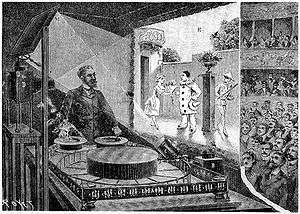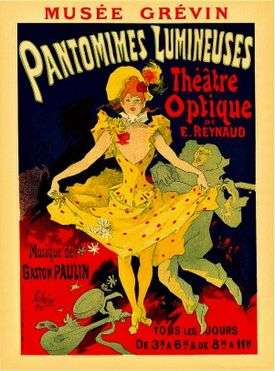Théâtre Optique

The Théâtre Optique was a moving picture show presented by Charles-Émile Reynaud in 1892. It was the first presentation of projected moving images to an audience, predating Auguste and Louis Lumière's first public performance by three years.
History
In 1876, Reynaud, a French inventor, had created the Praxinoscope, an improvement of the Zoetrope. The Praxinoscope replaced the narrow viewing slits of the Zoetrope with an inner circle of 12 mirrors (equal to the number of images), allowing a clearer and less distorted view of the moving image. Several people could watch the performance at the same time. After Reynaud licensed his invention in 1877, it sold well in a number of the large Paris department stores.
In 1878 Reynaud produced the Praxinoscope Theatre. This improved version included a glass viewing screen which allowed the moving image to be superimposed over a changeable background. He continued to improve the design and in 1880 created the first projection version. The Projection Praxinoscope used a lantern to project the moving images onto a small screen, allowing a larger audience to view it, but was still limited to 12 images.

In 1888, he perfected a large scale projection version, that was similar in design to the projectors that would be used for cinema projection a few years later. Glass plates, individually painted by Reynaud himself, were mounted in leather bands. Each of the bands were connected by a metal strip with a hole through it which allowed it to locate on a pin on the rotating drum and align the image with the projecting lantern. By mounting the connected image strips on a pair of wheels similar to modern film reels, Reynaud was able to create a continuous series of moving images rather than restricting himself to 12 images, as had been the limit previously.

On 28 October 1892 he gave the first public performance of a moving picture show at the Musée Grévin in Paris. The show, billed as Pantomimes Lumineuses, included three cartoons, Pauvre Pierrot, Un bon bock, and Le Clown et ses chiens, each consisting of 500 to 600 individually painted images and lasting about 15 minutes. Reynaud acted as the projectionist and the show was accompanied by a piano player. Although the films shown by the Lumière Brothers in 1895 eclipsed it, the show stayed at the Musée Grévin until 1900 by which time over 500,000 people had seen it.
References
- Sylvie Saerens (October 1997). "Emile Reynaud". Retrieved 8 December 2006.
- "Animation Notes #3 A Short History (part II)". RMIT University. Retrieved 8 December 2006.
- Chardère, B.; Borgé, G. and M. (1985). Les Lumière, Paris: Bibliothèque des Arts. ISBN 2-85047-068-6 (Language: French)
| Wikimedia Commons has media related to Théâtre Optique. |